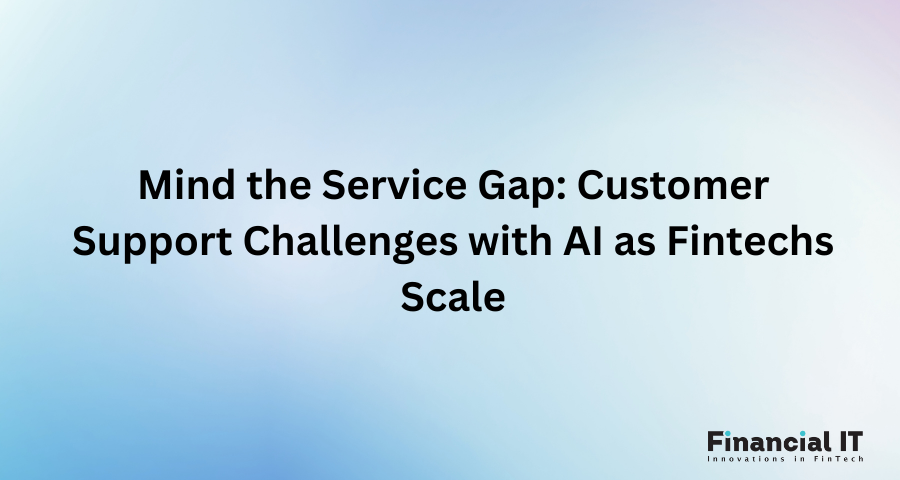Mind the Service Gap: Customer Support Challenges with AI as Fintechs Scale

- Dr. Efi Pylarinou, Global Fintech Influencer, Hans Zachar, Group Chief Information Officer at Nutun
- 04.04.2025 05:30 pm #AIinFintech #FintechScaling
In “My Big Fat Greek Wedding,” Gus Portokalos famously claimed Windex could fix anything from psoriasis to poison ivy. Today’s fintech world seems to have found its own Windex in AI — a supposed cure-all for every business challenge. Just spray some machine learning algorithms, add a GenAI-powered chatbot, and watch your operational inefficiencies disappear and your margins grow! Yet as Klarna’s journey from “AI can do all jobs” to “humans are invaluable” demonstrates, the reality is far more nuanced. Like any powerful tool, AI’s effectiveness depends not on blind application but on strategic implementation with customer needs at the centre.
As fintech matures into its second decade and adapts to the unfolding AI tech cycle, a crucial lesson is emerging: sustainable growth depends not on blindly chasing the latest technologies but on maintaining a laser focus on customer centricity.
Klarna’s journey: AI aspirations meet collections reality
The journey toward customer-centric AI integration isn’t always straightforward, as illustrated by Klarna’s recent confessions. The BNPL (Buy Now, Pay Later) giant has undergone a notable evolution from its September 2024 stance of wanting to be “OpenAI’s favorite guinea pig” and boldly claiming “AI can already do all of the jobs,” to their February 2025 recognition that “nothing will be as valuable as humans.”
This shift is particularly interesting when viewed alongside Klarna’s approach to collections — an area where customer experience is critically important and where the company has invested significantly in process optimisation. Apparently, Klarna follows a structured, customer-friendly approach to debt collection, using it only as a last resort after multiple attempts to collect payment directly:
- They send at least four “friendly reminders” over a seven-day period
- They employ multiple channels (app notifications, emails, text messages)
- They wait approximately four months before escalating to external debt collection agencies
This carefully calibrated approach has yielded impressive results, with credit losses remaining relatively low at 0.46% of total GMV as of September 2024. However, historical data indicates an upward trend from 0.37% during the same period in 2023. Despite this increase, Klarna’s debt collection referrals remain significantly below industry averages, with the company maintaining strict protocols before escalating to external collection agencies. This strategic debt management approach continues as Klarna prepares for its anticipated IPO in April 2025, with the company actively pursuing debt offloading strategies, including the sale of its US ‘Pay-in-Four’ loan portfolio to reduce balance sheet risk.
The collections conundrum: Where AI and human empathy meet
Collections has a bit of a stigma around it, but largely what collections is, is rehabilitating customers back into the credit lifecycle. In fact, the goal isn’t just recovery; it’s customer rehabilitation. Whether Klarna is dealing directly with its customers or through a partner collection agency, at the end of the day, it will all impact the customer experience.
Interestingly, when Klarna initially reduced their workforce by 22% and their CEO announced that they would further halve their workforce in favour of AI solutions, they may not have fully appreciated how this balance works in practice. Their subsequent strategic pivot suggests a recognition that AI works best to augment human interactions rather than an across the board replacement — particularly in sensitive areas like collections.
AI integration: Four key areas for nuanced implementation
When exploring AI integration in fintech, implementation must be nuanced and targeted rather than an indiscriminate replacement. There are four key areas where AI can make a meaningful difference while keeping the customer at the centre:
- Economic Optimisation: Given the cost of AI agents, you can now go quite a lot deeper into the collections book and still engage people in an empathetic way, in a compliant way at a very different price point. This allows fintechs to engage with accounts that might otherwise be unprofitable to service, expanding financial inclusion while maintaining viable economics.
- Resource Management: AI helps manage the peaks and troughs in customer service demand.
- Customer Segmentation: It’s important to identify which customers will respond best to which approach, for example, in a hybrid workforce of humans and AI, which kind of cases go to which cohorts of operators. This targeted approach is far more sophisticated than simply replacing humans with AI.
- Channel Optimisation: Some customers prefer text to voice, bots to humans, or vice versa. AI can help predict these preferences and route communications accordingly.
The key is using AI to enhance, not replace, human judgment and empathy. Ideally, AI deployment augments service providers and results in a superior and more personalised customer experience.
Key takeaways for fintech leaders
Klarna’s journey offers valuable lessons for fintech leaders looking to scale while maintaining customer focus:
- Strategic AI implementation: The path to effective AI integration is nuanced. Klarna’s journey from aggressive AI adoption to recognising the value of human interaction is a great lesson.
- Customer rehabilitation, not just collections: The focus on customer education and rehabilitation is more effective than traditional aggressive collection tactics. Fintechs must view collections as an opportunity to bring customers back into the credit lifecycle.
- Customer Centric AI deployment: Klarna`s default rates are low (less than 1%). It would be unfortunate if Klarna`s eagerness to adopt AI backfired simply because they prioritised cost reduction over customer centricity.
Looking ahead: 2025 and beyond
As we look to the future, the key to success in fintech customer service lies not in choosing between AI and human interaction, but in finding the right balance between the two. The goal is to maintain the efficiency and scalability that made fintech revolutionary while incorporating the human understanding and empathy that makes it sustainable.
The path forward isn’t about being “AI-first” or “human-first” — it’s about being “customer-first” and using all available tools appropriately.



















